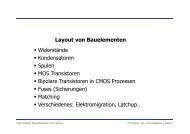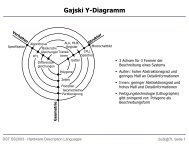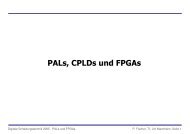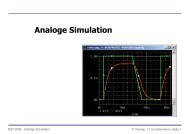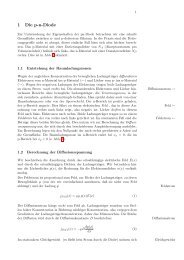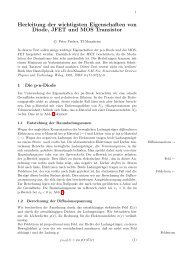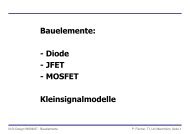Paper Title (use style: paper title) - Ziti
Paper Title (use style: paper title) - Ziti
Paper Title (use style: paper title) - Ziti
You also want an ePaper? Increase the reach of your titles
YUMPU automatically turns print PDFs into web optimized ePapers that Google loves.
On Achieving High Message Rates<br />
Holger Fröning Mondrian Nüssle Heiner Litz Christian Leber Ulrich Brüning<br />
Institute of Computer Engineering<br />
University of Heidelberg<br />
Mannheim, Germany<br />
{holger.froening, mondrian.nuessle, heiner.litz, christian.leber, ulrich.bruening}@ziti.uni-heidelberg.de<br />
Abstract— Computer systems continue to increase in<br />
parallelism in all areas. Stagnating single thread performance<br />
as well as power constraints prevent a reversal of this trend; on<br />
the contrary, current projections show that the trend towards<br />
parallelism will accelerate. In cluster computing, scalability,<br />
and therefore the degree of parallelism, is limited by the<br />
network interconnect and more specifically by the message<br />
rate it provides. We designed an interconnection network<br />
specifically for high message rates. Among other things, it<br />
reduces the burden on the software stack by relying on<br />
communication engines that perform a large fraction of the<br />
send and receive functionality in hardware. It also supports<br />
multi-core environments very efficiently through hardwarelevel<br />
virtualization of the communication engines. We provide<br />
details on the overall architecture, the thin software stack,<br />
performance results for a set of MPI-based benchmarks, and<br />
an in-depth analysis of how application performance depends<br />
on the message rate. We vary the message rate by software and<br />
hardware techniques, and measure the application-level<br />
impact of different message rates. We are also using this<br />
analysis to extrapolate performance for technologies with<br />
wider data paths and higher line rates.<br />
Keywords- computer communications, high performance<br />
networking, performance analysis, performance prediction<br />
I. INTRODUCTION<br />
Over the past years, there has been an increasing demand<br />
for more powerful computing systems. The TOP500 list [1]<br />
reveals that the vast majority of high performance computing<br />
systems are based on clusters, certainly due to their excellent<br />
price/performance ratio. Such clusters rely on commodity<br />
parts for computing, memory and enclosure, however, for<br />
highest performance they <strong>use</strong> specialized interconnection<br />
networks like Infiniband. Unlike clusters, Massively Parallel<br />
Processors (MPPs) make more <strong>use</strong> of specialized parts,<br />
which significantly increase performance but also cost.<br />
The overarching goal of the EXTOLL project is to fill the<br />
gap between clusters and MPPs, specifically with a system<br />
that combines the performance of an MPP with the costeffectiveness<br />
of a cluster. Workload analysis has determined<br />
that the message rate is one key characteristic that needs to<br />
be optimized to achieve this goal. In this <strong>paper</strong>, we will<br />
present a set of techniques utilized within the EXTOLL<br />
design, which enable high message rates, and show how<br />
applications can benefit from this improvement.<br />
The message rate is defined as the number of messages<br />
that can be injected into a network from a host per second.<br />
Thus, it describes the achievable bandwidth for small<br />
message sizes. Latency is of paramount importance for<br />
round-trip communication patterns; however, for<br />
unidirectional transfers its impact is negligible. For such<br />
push-<strong>style</strong> communication patterns, the message rate is much<br />
more significant. Not only do MPI applications benefit from<br />
high message rates, PGAS-<strong>style</strong> applications also express<br />
fine-grained communication patterns, which benefit a lot<br />
from high message rates [2].<br />
Taking into account that the increasing degree of<br />
parallelism [3] [4] also leads to an increased number of<br />
communication partners, communication pattern<br />
characteristics will shift to higher message counts with<br />
smaller payloads. Thus, the peak bandwidth is not the only<br />
metric that is crucial for the overall performance; instead, an<br />
increasing amount of attention must be paid to the<br />
performance of smaller messages. To conclude, the<br />
performance of small transfers should not only be<br />
characterized using the start-up latency, but also using the<br />
message rate.<br />
The message rate performance particularly depends on<br />
the network interface controller, which needs to be optimized<br />
for high efficiency in order to yield high message rates. The<br />
theoretical upper bound of the message rate is the link’s peak<br />
bandwidth divided by message size; a more practical upper<br />
bound is the link’s sustained bandwidth that takes into<br />
account the network protocol overhead. While we have<br />
presented details of the communication units for small [5]<br />
and large data transfers [6] in previous work, this work<br />
extends previous publications by providing the following<br />
contributions:<br />
1. An analysis of the impact of different message rates<br />
to communication-centric applications and<br />
workloads.<br />
2. Details of the optimized and lean interface between<br />
EXTOLL’s communication units and the<br />
corresponding software layers.<br />
3. The first comprehensive disclosure of performance<br />
results based on prototype hardware in a standard<br />
cluster environment.<br />
4. A methodology to characterize an application’s<br />
dependency on message rate, also allowing<br />
predicting application-level performance for future<br />
technologies.<br />
The remainder of this work is structured as follows: in<br />
the next section, we provide an analysis of sustained message<br />
rates. In the following two sections, we will introduce the
hardware and software architecture in detail. In section 5,<br />
performance results for the current prototype are reported.<br />
Section 6 is dedicated to the performance analysis for other<br />
technologies like ASICs. In section 7, we present related<br />
work, while the last section concludes.<br />
II.<br />
ON ACHIEVING HIGH MESSAGE RATES<br />
Theoretically, the effective bandwidth of a network can<br />
be translated into a message rate (MR) for a given packet<br />
size. Practically, this is only true for large packets where the<br />
overhead of packet passing is marginal compared to the<br />
packet size. For small payloads, more effects become visible<br />
and limit the message rate. The following components<br />
contribute to the sustained message rate:<br />
1. Network protocol overhead including framing,<br />
headers, CRC, etc<br />
2. Message passing protocol overhead including tags,<br />
source identification, etc<br />
3. Packet-to-packet gaps ca<strong>use</strong>d by network interface<br />
4. Packet-to-packet gaps ca<strong>use</strong>d by switching units<br />
5. Software overhead for sending and receiving<br />
The following Table I provides some numbers for two<br />
popular interconnection networks (10 Gigabit Ethernet and<br />
Infiniband QDR) and for EXTOLL, together with the<br />
sustained message rates achieved in our experiments. All<br />
message rates are reported in millions of messages per<br />
second.<br />
TABLE I.<br />
ANALYSIS OF SUSTAINED MESSAGE RATE<br />
Network 10GE 1 IB-QDR 2 EXTOLL 3<br />
Net Speed 10 Gbps 32 Gbps 5 Gpbs<br />
Theoretical peak<br />
message rate (8B<br />
payload)<br />
Network protocol<br />
overhead<br />
156.3 500.0 78.0<br />
82 B 38 B 32 B<br />
MPI protocol overhead 24 B 10 B 16 B<br />
Packet-to-Packet gap<br />
of switching units<br />
Packet-to-Packet gap<br />
of network interface<br />
Overhead total (as<br />
appropriate)<br />
Sustained Message<br />
Rate<br />
Calculated overhead<br />
derived from sustained<br />
MR<br />
NA NA 8 B<br />
NA NA 0 B<br />
114 B<br />
(w/o gaps)<br />
0.66<br />
(0.42%)<br />
56 B<br />
(w/o gaps)<br />
6.67<br />
(1.33%)<br />
64 B<br />
(total)<br />
9.73<br />
(12.4%)<br />
416.67 B 599.70 B 64.14 B<br />
For theoretical peak message rate the assumed minimum<br />
payload is 8 bytes. Sustained message rate is the peak<br />
measure rate achieved with multiple communication pairs,<br />
also reported as percentage of theoretical peak.<br />
1<br />
Intel 82598EB 10GE controller, no switch. 2x AMD Opteron<br />
2380 (4 cores, 2.5GHz) per node, Open-MPI 1.4.2<br />
2<br />
Mellanox MT26428 with MTS3600 switch, 1x Intel Xeon E5645<br />
(6 cores, 2.4GHz) per node, MVAPICH 1.2.0<br />
3<br />
EXTOLL R1, 2x AMD Opteron 2380 (4 cores, 2.5GHz) per<br />
node, Open-MPI 1.4.2<br />
We report detailed numbers in Table I for our EXTOLL<br />
network prototype, but best to our knowledge such numbers<br />
are not published from typical network vendors. Note that<br />
the table does not include numbers for software overhead, as<br />
due to overlap between software and hardware processing<br />
these numbers cannot be determined with sufficient<br />
accuracy. While the overheads for network and MPI protocol<br />
are similar for all three network types, the ratios of sustained<br />
vs. theoretical message rates differ significantly. The last row<br />
presents the corresponding calculated overhead in bytes<br />
derived from the sustained message rate. This overhead<br />
attributes to several potential sources: protocols, network<br />
interface, switching units and software overhead.<br />
EXTOLL’s calculated overhead matches closely the total<br />
overhead from the network interface and switching units<br />
(64.14B vs. 64B), validating our calculation, but also<br />
showing that our software overhead is minimal. On the other<br />
hand, the two other networks show a huge difference<br />
between the calculated overhead and analyzed overhead.<br />
Although we had to omit numbers for gaps ca<strong>use</strong>d by<br />
network interfaces and switching units, the difference is too<br />
big to attribute it only to these hardware units. We assume<br />
that these networks suffer from huge software overheads.<br />
Thus, our network design is very competitive compared to<br />
existing solutions and therefore allows analyzing the impact<br />
of message rate at application level.<br />
III.<br />
AN ARCHITECTURE FOR HIGH MESSAGE RATES<br />
In brief, EXTOLL’s main characteristics are support for<br />
multi-core environments by hardware-level virtualization,<br />
communication engines for very low overhead and a<br />
minimized memory footprint. Figure 1 shows a top-level<br />
block diagram of the EXTOLL architecture, integrating the<br />
host interface, network interface and switching units. The<br />
host interface is based on HyperTransport (HT), but could be<br />
replaced by PCIe logic (which in fact in another design is<br />
being done). The on-chip network HTAX closely matches<br />
the HT protocol, but overcomes some shortcomings with<br />
regard to the limited amount of source tags and the<br />
addressing scheme.<br />
The second large block implements the different modules<br />
needed for message handling, i.e. to inject messages into the<br />
network and receive messages from the network. The two<br />
major communication units are the Virtualized Engine for<br />
Low Overhead (VELO), supporting programmed I/O (PIO)<br />
for small transfers, and the Remote Memory Access (RMA)<br />
unit that, <strong>use</strong>s DMA to handle large messages. The two<br />
supporting units are the Address Translation Unit (ATU) and<br />
the control & status register file.<br />
The last block implements a complete network switch. It<br />
includes a crossbar-based switch, six ports towards the<br />
network side and three ports towards the message handling<br />
modules on the host side, allowing handling requests,<br />
responses and completions independently.<br />
A. Switching Resources Integrated into Network Interface<br />
The EXTOLL prototype can run any direct topology with<br />
a maximum node degree of six. The routing hardware is not<br />
limited to a certain strategy, like dimension order routing,
nor to a specific topology. For smaller networks, for instance<br />
different variants from fully interconnected to hypercube and<br />
tori are available. Larger configuration will most probably<br />
<strong>use</strong> a 3D torus configuration, though, based on the available<br />
number of links.<br />
Host Interface<br />
Hyper-<br />
Transport<br />
IP Core<br />
HTAX<br />
XBar<br />
NIC<br />
ATU<br />
VELO<br />
RMA<br />
C&S<br />
Registerfile<br />
Linkport<br />
Networkport<br />
Networkport<br />
Figure 1. Top-level architecture<br />
Network<br />
Network<br />
XBar<br />
Linkport<br />
Linkport<br />
Linkport<br />
Linkport<br />
Linkport<br />
Networkport<br />
The integrated switch implements a variant of Virtual<br />
Output Queuing (VOQ) on the switch level to reduce Headof-line<br />
(HOL) blocking and employs cut-through switching.<br />
Multiple virtual channels are <strong>use</strong>d for deadlock avoidance. In<br />
particular in-order delivery of packets and reliable packet<br />
transmission significantly simplifies the protocol design in<br />
MPI layers, allowing for very low software overhead as can<br />
be seen in Table I.<br />
B. Support for Small Data Transfers<br />
As the network is designed particularly for ultra-low<br />
latencies and high message rates, EXTOLL includes a<br />
special hardware unit named VELO that provides optimized<br />
transmission for small messages. It offers a highly efficient<br />
hardware and software interface to minimize the overhead<br />
for sending and receiving such messages. Using VELO,<br />
messages are injected into the network using PIO to reduce<br />
the injection latency as much as possible. Details of this<br />
scheme, as well as for the general architecture of VELO can<br />
also be found in [5]. Here, we extend this work with details<br />
of the software part and its impact on application-level<br />
performance.<br />
velo_ret_t velo_send(velo_connection_t* handle,<br />
uint32_t len, uint64_t* buf, uint8_t tag)<br />
{<br />
uint64_t* dest= calc_address (handle, tag, len);<br />
for ( i=0; i < ( len>>3 ); i ++ )<br />
*dest++ = *buf++;<br />
return VELO_RET_SUCCESS;<br />
}<br />
For VELO, a single write operation into the memorymapped<br />
I/O (MMIO) space is sufficient to send a message.<br />
For additional optimization, some of the message header<br />
information is encoded in the address to access VELO. This<br />
implementation saves space in the data section of the I/O<br />
transaction. The code snippet above helps to illustrate the<br />
software part of issuing a message to VELO.<br />
As one can see, there are only two simple steps required<br />
to inject the message: First, calculate the target address of the<br />
store instruction, and second, copy the message to the device.<br />
A simple loop can be <strong>use</strong>d here. The write-combining feature<br />
of modern CPUs is employed to aggregate the data of one<br />
message into a single host-to-interface transaction. An<br />
exception mechanism exists in hardware to address the case<br />
in which a transaction is split by the CPU, for example<br />
ca<strong>use</strong>d by an interrupt that occurs in the middle of a<br />
transaction. Access to VELO is done directly from <strong>use</strong>rspace.<br />
Each process has distinct mappings, so hardware can<br />
immediately determine if the process is actually authorized<br />
to send messages.<br />
The VELO hardware unit is a completely pipelined<br />
structure controlled by a number of finite state machines. So<br />
no (relatively) slow microcode or even embedded processing<br />
resource is involved in sending or receiving data. Another<br />
fact that has important consequences on performance is the<br />
amount and the location of context or state information for<br />
the hardware. VELO is stateless in the sense that each<br />
transaction is performed as a whole and no state must be<br />
saved for one message to proceed. As a corollary, there is no<br />
context information stored in main memory and no caching<br />
of such information is necessary. Thus, VELO is able to<br />
provide high performance independent of the actual access<br />
pattern by different processes, a very important fact in<br />
today’s multi- or many-core systems.<br />
On the receive side, messages are written directly to main<br />
memory using a single ring-buffer per receiving process.<br />
Each process allocates its own receive buffer, and any source<br />
can store messages to this ring-buffer. User-level processes<br />
waiting for messages can poll certain memory locations<br />
within this ring buffer for new arrivals. This can be done in a<br />
coherent way, so polling is done on cache copies. Updates in<br />
the ring buffers invalidate the now outdated copies,<br />
enforcing the subsequent access to fetch the most recent<br />
value from main memory.<br />
The simplest flavor of a receive function is shown in the<br />
code snippet below. After determining the address to poll,<br />
the function waits for a new message to arrive. It<br />
subsequently copies the data to the application buffer,<br />
increments the internal read pointer and resets the header<br />
word to zero to prepare for the next time this slot will be<br />
<strong>use</strong>d. The first quad word of a message in the VELO receive<br />
buffer is guaranteed to non-zero, identifying a valid packet.<br />
velo_ret_t velo_recv_wait(velo_port_t* handle,<br />
uint32_t len, uint64_t* buf)<br />
{<br />
volatile uint64_t* s = handle->header;<br />
while (*(s) == 0l ) { /* busy wait*/ };<br />
memcpy ( buf, ( void* ) handle->msg, len );<br />
_velo_recv_inc_rp ( handle );<br />
handle->header = 0l;<br />
return VELO_RET_SUCCESS;<br />
}<br />
For the VELO transport, the order is maintained by<br />
utilizing the hardware’s underlying flow-control principles,<br />
i.e. EXTOLL’s flow-control in the network and
HyperTransport’s flow-control for the host side. In extreme<br />
cases, this can lead to stalling CPU cores due to missing<br />
credits, which are needed to inject messages. To solve this<br />
problem a programmable watchdog is provided which<br />
prevents system crashes in such a case. On the software side,<br />
the problem can be avoided by using a higher-level flowcontrol.<br />
The actual hardware implementation has been<br />
improved from the implementation described in [5] in such a<br />
way. Also, we increased both frequency and data path width.<br />
C. Support for Bulk Data Transfers<br />
Larger transfers are efficiently supported using the RMA<br />
unit. The RMA unit offers Put/Get based primitives. There is<br />
a hardware-based Address Translation Unit (ATU), which<br />
secures memory accesses from <strong>use</strong>r-space. Registration and<br />
deregistration of pages is very fast and only limited by the<br />
time for a system call and the lookup of the virtual to<br />
physical translation by the kernel itself [6].<br />
RMA allows for complete CPU-offloading, which is<br />
crucial for high overlap between computation and<br />
communication. Processors only have to post RMA<br />
command descriptors to the hardware using PIO. The<br />
complete data transmission, however, is executed by<br />
integrated DMA engines.<br />
An interesting feature that has been <strong>use</strong>d for the MPI<br />
implementation (see below) is the notification framework;<br />
allowing notifying processes at the sending, responding or<br />
completing side of a Put resp. Get operations. Obviously<br />
notifications for responses are only applicable to Get<br />
operations. Each process has exactly one notification queue,<br />
in which the hardware stores all incoming notifications for<br />
this process regardless of their type. These queues share<br />
many similarities with VELO receive queues.<br />
IV.<br />
SOFTWARE STACK<br />
The software stack of the EXTOLL prototype is divided<br />
into the <strong>use</strong>r-space part and the Linux kernel part. The actual<br />
process of sending and receiving messages is completely<br />
done in <strong>use</strong>r-space. There are two low-level API libraries,<br />
one for VELO and one for RMA. Functions for a <strong>use</strong>rapplication<br />
to request hardware access, set-up memorymappings<br />
and allocate receive queues are provided. For<br />
VELO, there are different flavors of send() and receive()<br />
functions available. A VELO context provides a single<br />
receive ring-buffer to the application, to which all messages<br />
destined to this application are written to by the hardware.<br />
For efficiency reasons, and to avoid stalling of the sending<br />
CPU-cores, a credit-based flow-control scheme has been<br />
implemented [7]. Measurements show that the performance<br />
is not significantly impacted by this additional software<br />
protocol.<br />
On the RMA side, there are functions to register and deregister<br />
memory regions. One set of functions allows the <strong>use</strong>r<br />
application to post arbitrary commands like put or get<br />
requests to the hardware. Another set of functions manages<br />
the notification queue, into which the hardware writes<br />
notifications to inform software about completed operations.<br />
A. Supporting MPI<br />
There exist several popular open source choices for the<br />
MPI implementations. We chose OpenMPI, mainly beca<strong>use</strong><br />
the component-oriented architecture is well understood and<br />
formed a clean interface to the EXTOLL lower-level<br />
software. Within OpenMPI, there are again several interfaces<br />
available that can be <strong>use</strong>d to implement support for a<br />
transport method. We chose the Message Transfer Layer<br />
(MTL) interface for EXTOLL. This interface is actually quite<br />
simple and encompasses only a small number of functions,<br />
for instance initialization and finalization functions, blocking<br />
and non-blocking send functions, and a callback-oriented<br />
progress function. A number of other functions for example<br />
to cancel or test requests are also available. Compared to<br />
other interfaces, in particular the Bit Transfer Layer (BTL),<br />
the downside of the MTL component is that MPI matching<br />
semantics have to be implemented. On the other hand, this<br />
allows optimizing matching semantics for our network<br />
design.<br />
EXTOLL<br />
PCI<br />
Configspace<br />
libVELO<br />
Basedriver<br />
User-Application<br />
OpenMPI<br />
Message Transfer Layer (MTL component for OpenMPI)<br />
velodrv<br />
rmadrv<br />
EXTOLL Hardware<br />
atudrv<br />
libRMA<br />
VELO RMA ATU Registerfile<br />
Figure 2. Software stack<br />
extoll_rf<br />
User<br />
Space<br />
Kernel<br />
Space<br />
Two protocols are implemented to transport messages<br />
using the EXTOLL hardware, with a tunable run-time<br />
parameter. There is an eager protocol for small messages and<br />
a rendezvous protocol for large messages. For the<br />
experiments in this work, the threshold was set to 2 kB.<br />
B. Eager protocol<br />
The eager protocol relies on the VELO engine. First, a<br />
MPI header is built mainly consisting of source process, tag,<br />
communicator and size information. This MPI header along<br />
with the actual data is then sent to the destination process<br />
using VELO send functions. On the receiver side, the VELO<br />
receive queue is checked by the progress function. Every<br />
incoming entry is software-matched against the receive<br />
queue using the MPI header which can be found at the<br />
beginning of the message. If no match is found, the message<br />
NIC
Messages/second [in millions]<br />
Messages/second [in millions]<br />
is added to the unexpected queue. If a matching receive is<br />
posted later, this receive can immediately be completed via<br />
the unexpected queue. A hardware VELO message has a<br />
maximum size of 64 bytes in the EXTOLL prototype. Larger<br />
messages are assembled from multiple VELO messages.<br />
VELO messages can carry a small tag that is <strong>use</strong>d to<br />
distinguish different message types on this protocol layer, for<br />
example if this is the first fragment of a larger MPI message.<br />
The software also leverages the fact that VELO messages<br />
arrive in the same order as they were originally sent.<br />
C. Rendezvous protocol<br />
The rendezvous protocol is built upon both VELO and<br />
RMA engines. First, a request message is built and sent to<br />
the receiver using VELO. Once this request is matched at the<br />
receiver, a sequence of RMA Get operations is <strong>use</strong>d to fetch<br />
the data from the sender into the receiver’s application<br />
buffer. The memory at the sender side is registered right<br />
before the request is sent; the receiver registers its buffer<br />
when starting the Get operation. For the rendezvous protocol,<br />
notifications are <strong>use</strong>d to signal completion both on sender<br />
and receiver sides. After these notifications have been<br />
received, the respective buffers are de-registered.<br />
V. PROTOTYPE PERFORMANCE RESULTS<br />
The architecture described in the last two sections is<br />
currently implemented as a prototype using reconfigurable<br />
hardware, i.e. Field Programmable Gate Arrays (FPGAs).<br />
We developed a custom add-in card [8] combining the FPGA<br />
with an HTX connector as host interface and six serial links<br />
towards the network side. We <strong>use</strong> standard optical<br />
transceivers and fibers to connect these add-in cards. The<br />
implemented architecture is running at a frequency of 156<br />
MHz with a data path width of 32 bits for the core logic, i.e.<br />
the NIC and network block, and 200 MHz for the HT Core.<br />
An 8 node cluster is equipped with these custom add-in cards<br />
and a 3D torus is set up. Each node includes two 4-core<br />
AMD Opteron 2380 processors running at 2.5 GHz, and 8<br />
GB of DDR2-800 main memory. Linux version 2.6.31.6 is<br />
installed on these machines.<br />
Our prototype is suffering from some performance<br />
limitations due to the <strong>use</strong>d technology. Compared to ASICs,<br />
FPGAs are limited in terms of capacity and frequency, as<br />
well as flexibility due to integrated hard IP blocks. In<br />
particular, the link bandwidth is limited to only 6.24 Gbps<br />
and the hop latency is about 300ns, mainly due to the hard IP<br />
modules <strong>use</strong>d for serialization.<br />
A. Message rate<br />
First, we report message rate characteristics based on the<br />
popular OSU Message Rate Test [9]. It reports the sustained<br />
message rate, i.e. how many send operations can be issued<br />
per second. For this test, multiple communication pairs are<br />
set up between two nodes. No message aggregation or other<br />
techniques are <strong>use</strong>d to optimize this experiment.<br />
Figure 3 shows the results of this test. We achieve a peak<br />
non-coalesced message rate of more than 9.5 million<br />
messages per second; yielding a peak bandwidth of 480<br />
MB/s. For comparison, we have also included the results<br />
from our IB-QDR experiment in this figure, which is the<br />
same as in Table I. The message rate achieved with 10GE is<br />
not competitive and only included for reference.<br />
12.00<br />
10.00<br />
Figure 3. OSU Message Rate Test – Performance over Message Size<br />
The maximum message rate for a varying numbers of<br />
communication pairs is shown in Figure 4. EXTOLL<br />
requires four simultaneous pairs to saturate, likely due to<br />
MPI layer overhead. However, while IB-QDR also requires<br />
four pairs to reach its peak, it does not maintain this<br />
performance level but instead performance starts dropping<br />
significantly.<br />
VI.<br />
8.00<br />
6.00<br />
4.00<br />
2.00<br />
0.00<br />
12.00<br />
10.00<br />
8.00<br />
6.00<br />
4.00<br />
2.00<br />
0.00<br />
Message size [B]<br />
EXTOLL R1<br />
IB QDR<br />
10GE<br />
EXTOLL R1<br />
IB QDR<br />
10 GE<br />
Figure 4. OSU Message Rate - Performance over Pair Count<br />
PERFORMANCE ANALYSIS AND EXTRAPOLATION<br />
As our prototype is based on FPGAs instead of much<br />
faster ASICs, we present here a methodology allowing<br />
estimating application-level performance for faster<br />
technologies. In addition, we show that two complex<br />
application-level benchmarks (HPCC RandomAccess and<br />
Weather Research and Forecasting Model) heavily depend<br />
on the message rate. To estimate the relative performance of<br />
future versions we rely on simulation- and calculation-based<br />
analyses, which are summarized in Table II. As for future<br />
versions not only the frequency is varied but also the data
normalized run time<br />
normalized run time<br />
path width increases, we assume that an increase to 64 bit at<br />
300 MHz translates to a relative performance of 600 MHz at<br />
32 bit (or 384%), respectively a 800 MHz at 128 bit<br />
translates to 2400 MHz at 32 bit (or 1538%).<br />
TABLE II.<br />
Technology<br />
Virtex-4 FPGA<br />
Virtex-6 FPGA<br />
65nm ASIC<br />
PERFORMANCE INCREASE FOR DIFFERENT TECHNOLOGIES<br />
Core<br />
speed<br />
156<br />
MHz<br />
300<br />
MHz<br />
800<br />
MHz<br />
Data<br />
path<br />
width<br />
Relative<br />
frequency<br />
Relative<br />
message<br />
rate<br />
32 bit 100% 100%<br />
64 bit 384% 400%<br />
128 bit 1538% 1000%<br />
A. Methodology<br />
In order to predict the performance of future EXTOLL<br />
implementations we apply the following methodology. First,<br />
we reduce the performance of the FPGA prototype in two<br />
manners:<br />
1. The message rate is reduced by including delays<br />
after the send function in the API. As this is done<br />
after the send function there should be little<br />
influence on latency.<br />
2. The core speed of the FPGA is reduced, which<br />
influences the message rate, latency and bandwidth.<br />
Then, we rerun the micro-benchmarks to determine the<br />
correlation to the message rate, latency and bandwidth. In<br />
addition, we <strong>use</strong> complex benchmarks to determine the<br />
impact on application-level performance like GUPS and<br />
GFLOP/s. We apply a best fit to the different measurement<br />
points and extrapolate the resulting function to determine the<br />
impact of faster ASIC and FPGA technologies. As long as<br />
the system performance is not limited by third-order effects<br />
like the processor or main memory, this extrapolation should<br />
provide reasonable results.<br />
1) Message Rate Variation<br />
This is achieved by including delays in the API blocking<br />
and non-blocking send call after actually triggering the send<br />
operation. The delay is dependent on the message size, thus<br />
the longer a message is, the longer is the delay is. We <strong>use</strong><br />
command line parameters to choose between several delay<br />
sets, yielding different message rates. Obviously, this also<br />
has an impact on bandwidth; however, this satisfies the<br />
definition of the message rate. For messages smaller than<br />
128 bytes, the latency is not affected. For larger messages,<br />
the delay required to achieve a certain message rate also<br />
affects latency, but the latency impact for these messages<br />
sizes is not crucial.<br />
In this way, we have selected sets of delay parameter to<br />
configure the network for certain message rates, varying<br />
between 100% and 70% of peak message rate.<br />
2) Frequency Variation<br />
Although some hard IP blocks prevent us from choosing<br />
arbitrary core frequencies we have found a set of four<br />
frequencies, shown in Table III together with relative<br />
performance, averaged over all message sizes.<br />
Frequency<br />
TABLE III.<br />
Relative<br />
frequency<br />
IMPACT OF FREQUENCY VARIATION<br />
Message<br />
rate<br />
Bandwidth<br />
Latency<br />
156 MHz 100.00% 100.00% 100.00% 100.00%<br />
140 MHz 89.74% 88.62% 92.64% 93.16%<br />
125 MHz 80.13% 79.21% 85.23% 87.18%<br />
117 MHz 75.00% 74.61% 80.89% 83.79%<br />
B. Experiments<br />
We employ the HPCC RandomAccess benchmark [10]<br />
and the Weather Research and Forecasting (WRF) model<br />
[11] on 8 nodes with 64 processes to characterize the<br />
application-level impact of varying message rates.<br />
1) HPCC RandomAccess<br />
First, we vary the message rate. We expect a high<br />
influence on the HPCC RandomAccess results, as this<br />
benchmark relies on a massive exchange of small messages.<br />
2.50<br />
2.00<br />
1.50<br />
1.00<br />
0.50<br />
0.00<br />
communication fraction<br />
computation fraction<br />
Performance/message rate correlation<br />
70% 75% 80% 85% 90% 95% 100%<br />
Normalized Message Rate<br />
60.00%<br />
40.00%<br />
20.00%<br />
0.00%<br />
-20.00%<br />
-40.00%<br />
-60.00%<br />
Figure 5. Message rate sensitivity for HPCC RandomAccess<br />
Figure 5 shows the measurement results, reported in<br />
normalized run time components for communication and<br />
computation, and the performance-message rate correlation.<br />
We assume that our instrumentation is only influencing the<br />
communication time and not the computation time. Negative<br />
values in the correlation indicate that the performance<br />
decrease is bigger than the message rate decrease, and vice<br />
versa. The configurations for 95%-70% of message rate<br />
show the expected high correlation. However, the sharp<br />
performance drop from 100% to 95% is unexpected. A<br />
possible explanation for this super-linear slow-down might<br />
be the effect of the delay after message sending which, as a<br />
side effect, also sacrifices compute time. Thus, we remove<br />
this setting from our calculations.<br />
1.40<br />
1.20<br />
1.00<br />
0.80<br />
0.60<br />
0.40<br />
0.20<br />
0.00<br />
communication fraction<br />
computation fraction<br />
Performance/frequency correlation<br />
75% 80% 90% 100%<br />
Normalized Frequency<br />
60.00%<br />
40.00%<br />
20.00%<br />
0.00%<br />
-20.00%<br />
-40.00%<br />
-60.00%<br />
Figure 6. Frequency sensitivity for HPCC RandomAccess
GFLOP/s<br />
GUPS<br />
Figure 6 shows the performance results when varying<br />
frequency. In this case, all measurement points show a high<br />
correlation and can be <strong>use</strong>d for extrapolation.<br />
Based on these results, we <strong>use</strong> an exponential best fit on<br />
the communication time, measured using mpiP [12]. For 64<br />
processes on 8 nodes, this benchmark spends 89% of its<br />
execution time within MPI layers. The computing time<br />
fraction is kept constant as the amount of work (i.e.<br />
processing updates) is not varied. Figure 7 shows the<br />
resulting performance in terms of GUPS, saturating at more<br />
than 1.8 GUPS. We achieve a high match between the two<br />
<strong>use</strong>d variations, validating our approach.<br />
2.00000<br />
1.80000<br />
1.60000<br />
1.40000<br />
1.20000<br />
1.00000<br />
0.80000<br />
0.60000<br />
0.40000<br />
0.20000<br />
0.00000<br />
0% 200% 400% 600% 800% 1000% 1200% 1400% 1600%<br />
Figure 7. HPCC RandomAccess performance extrapolation<br />
2) WRF– Message rate variation<br />
The same methods are applied to WRF. Figure 8 shows<br />
the resulting performance, based on an MPI time of 45.00%<br />
for WRF on 8 nodes and 64 processes.<br />
100.00000<br />
90.00000<br />
80.00000<br />
70.00000<br />
60.00000<br />
50.00000<br />
40.00000<br />
30.00000<br />
20.00000<br />
10.00000<br />
Normalized Frequency / Message Rate<br />
GUPS extrapolated using<br />
frequency variation<br />
(64P8N)<br />
GUPS extrapolated using<br />
message rate variation<br />
(64P8N)<br />
GFLOP/s extrapolated using<br />
frequency variation (64P8N)<br />
0.00000<br />
0% 200% 400% 600% 800% 1000% 1200% 1400% 1600%<br />
Normalized Frequency / Message Rate<br />
GFLOP/s extrapolated using<br />
message rate variation (64P8N)<br />
Figure 8. WRF performance extrapolation<br />
The two variations show a very nice fit, in particular for<br />
the 400% setting and above. The difference for smaller input<br />
values can be explained by the more complex nature of this<br />
benchmark and the higher influence of frequency variation<br />
with regard to bandwidth.<br />
3) Summary<br />
The outcome of the performance analysis and<br />
extrapolation is summarized in Table IV. Although one<br />
might claim that for both experiments our ASIC-based<br />
version is located in the saturation of the performance graph,<br />
we would like to note that this only applies for these two<br />
benchmarks and that this is only an 8-node cluster. For larger<br />
installations, saturation will likely be reached much later.<br />
TABLE IV.<br />
EXTOLL<br />
version<br />
HPCC<br />
Random<br />
Access<br />
WRF<br />
SUMMARY OF PERFORMANCE EXTRAPOLATION<br />
Method<br />
Message<br />
rate<br />
variation<br />
Frequency<br />
variation<br />
Message<br />
rate<br />
variation<br />
Frequency<br />
variation<br />
FPGA<br />
156 MHz,<br />
32bit<br />
0.20853<br />
GUPS<br />
48.50262<br />
GFLOP/s<br />
FPGA<br />
300<br />
MHz,<br />
64bit<br />
1.452<br />
GUPS<br />
1.538<br />
GUPS<br />
VII. RELATED WORK<br />
81.833<br />
GFLOP/s<br />
79.319<br />
GFLOP/s<br />
ASIC<br />
800 MHz,<br />
128bit<br />
1.895<br />
GUPS<br />
1.896<br />
GUPS<br />
88.161<br />
GFLOP/s<br />
88.180<br />
GFLOP/s<br />
A large amount of work has been published on<br />
interconnection networks and their performance impact on<br />
HPC systems. Due to its popularity, most of the research<br />
targets the Infiniband architecture, in particular the ConnectX<br />
technology provided by Mellanox [13]. Sur et al. provide a<br />
detailed performance evaluation of the ConnectX architecture<br />
in [14]. Another established network protocol is Ethernet,<br />
and more recently, 10G Ethernet. Hurwitz has studied the<br />
performance of 10G Ethernet on commodity systems [15].<br />
Furthermore, several vendors have developed proprietary<br />
network technologies. This includes Cray’s Seastar family,<br />
which is extensively studied by Brightwell in [16]. Seastar is<br />
similar to EXTOLL, however, lacks efficient <strong>use</strong>r-level<br />
communication and virtualization support. The successor of<br />
Seastar is Cray’s Gemini [17]. Fujitsu has proposed its Tofu<br />
network [18], which supports 6-dimensional Torus<br />
topologies with high fault tolerance using multidimensional<br />
routing paths. IBM has developed a series of proprietary<br />
interconnects, including its Blue-Gene family [19] and<br />
PERCS [20]. The Shaw research institute claims a 162 ns<br />
end-to-end communication latency with Anton [21], an ASIC<br />
that integrates both interconnect and highly specialized<br />
processor for executing molecular dynamics simulations.<br />
However, it only supports a small set of applications and is<br />
not compatible with general-purpose software.<br />
The HPCC RandomAccess benchmark has been studied<br />
in detail [10] [22] [23], but not with regard to varying<br />
message rate. Similar applies to the Weather Research and<br />
Forecasting Model [11] [24].<br />
VIII. CONCLUSION<br />
We present a network architecture specifically designed<br />
for high message rates, including hardware modules and<br />
software layers. In particular, we describe the properties and<br />
characteristics that enable our design to offer high message<br />
rates, and put our performance results in context with other<br />
popular interconnection networks.<br />
For in-depth analysis and evaluation, we have designed<br />
an entire hardware and software stack, rather than a<br />
simulation model. This allows us to test our architecture on<br />
an FPGA-based prototype cluster consisting of 8 computing<br />
nodes. As opposed to experiments based solely on
simulations, we can now perform comprehensive<br />
experiments, covering all aspects of an HPC system.<br />
The FPGA implementation achieves a message rate<br />
exceeding 9 million messages per second, which is very<br />
competitive considering the performance-limiting FPGA<br />
technology. Apart from such micro-benchmark results, we<br />
report measurements of applications including the Weather<br />
Research & Forecasting Model and the HPCC<br />
RandomAccess benchmark.<br />
For a detailed analysis of the impact of message rate on<br />
application-level performance, we modify our design in two<br />
ways to provide different message rates to the application.<br />
First, we delay send operations to manually create gaps<br />
between subsequent messages. Second, we vary the clock<br />
frequency, which obviously also impacts message rate.<br />
The outcome of this analysis is two-fold: first, we show<br />
that the performance of applications like the HPCC<br />
RandomAccess and the Weather Research & Forecasting<br />
Model highly depends on the provided message rate. Second,<br />
this analysis allows us to extrapolate performance for other<br />
technologies. This includes more recent FPGAs but also<br />
ASICs, which allow for both higher clock frequencies and<br />
wider data paths.<br />
IX.<br />
ACKNOWLEDGMENTS<br />
We thank the anonymous reviewers for their constructive<br />
comments. Also, we would like to thank all the people that<br />
contributed to the continuing success of the EXTOLL<br />
project. In no particular order, we want to especially thank<br />
Frank Lemke, Alexander Giese, Sven Kapferer, Benjamin<br />
Geib, Niels Burkhardt, Sven Schenk, Benjamin Kalisch,<br />
Myles Watson and Richard Leys for all their support and<br />
ongoing work, without EXTOLL would never have been<br />
possible.<br />
X. REFERENCES<br />
[1] TOP500 list: http://www.top500.org<br />
[2] Underwood, K. D., Levenhagen, M. J., and Brightwell, R. 2007.<br />
Evaluating NIC hardware requirements to achieve high message rate<br />
PGAS support on multi-core processors. In Proceedings of the 2007<br />
ACM/IEEE Conference on Supercomputing (SC '07). ACM, New<br />
York, NY, USA.<br />
[3] Asanovic, K., et al. 2009. A view of the parallel computing<br />
landscape. Communications of the ACM, 52(10), 56-67.<br />
[4] Kogge P. (Ed.), et al. 2008. ExaScale Computing Study: Technology<br />
Challenges in Achieving Exascale Systems. US Department of<br />
Energy, Office of Science, Advanced Scientific Computing Research,<br />
Washington, DC. Available at http://www.er.doe.gov/ascr.<br />
[5] Litz, H., Fröning, H., Nüssle, M., and Brüning, U. 2008. VELO: A<br />
novel communication engine for ultra-low latency message transfers.<br />
In Proceedings of 37th International Conference on Parallel<br />
Processing (ICPP-2008), Sept. 08-12, 2008, Portland, Oregon, USA.<br />
[6] Nüssle, M., Scherer, M., and Brüning, U. 2009. A resource optimized<br />
remote-memory-access architecture for low-latency communication.<br />
In Proceedings of 38th International Conference on Parallel<br />
Processing (ICPP-2009), Sept. 22-25, Vienna, Austria.<br />
[7] Prades, J., Silla, F., Duato, J., Fröning, H., Nüssle, M. 2012. A New<br />
End-to-End Flow-Control Mechanism for High Performance<br />
Computing Clusters. In Proceedings of IEEE International<br />
Conference on Cluster Computing (CLUSTER2012), Sept. 24-28,<br />
2012, Beijing, China<br />
[8] Fröning, H., Nüssle, M., Slogsnat, D., Litz, H., and Brüning, U. 2005.<br />
The HTX-Board: A Rapid Prototyping Station. In Proceedings of 3rd<br />
annual FPGAworld Conference, Nov. 16, 2006, Stockholm, Sweden.<br />
[9] OSU Micro-Benchmarks 3.3: http://mvapich.cse.ohiostate.edu/benchmarks,<br />
last accessed Apr. 2011.<br />
[10] Aggarwal, V., Sabharwal, Y., Garg, R., and Heidelberger, P. 2009.<br />
HPCC RandomAccess benchmark for next generation<br />
supercomputers. In Proceedings of the 2009 IEEE International<br />
Symposium on Parallel & Distributed Processing (IPDPS '09). IEEE<br />
Computer Society, Washington, DC, USA, 1-11.<br />
[11] Michalakes, et al. Development of a next generation regional weather<br />
research and forecast model. In Proceedings of the Ninth ECMWF<br />
Workshop on the Use of High Performance Computing in<br />
Meteorology. Eds. Walter Zwieflhofer and Norbert Kreitz. World<br />
Scientific, Singapore. pp. 269-276.<br />
[12] Vetter, J., and Chambreau, C. mpiP: Lightweight, Scalable MPI<br />
Profiling: http://mpip.sourceforge.net, last accessed Apr. 2011.<br />
[13] Mellanox Technologies: http://www.mellanox.com.<br />
[14] Sur, S., Koop, M. J., Chai, L., and Panda, D.K. 2007. Performance<br />
analysis and evaluation of Mellanox ConnectX InfiniBand<br />
architecture with multi-core platforms. In 15th IEEE Symposium on<br />
High Performance Interconnects (HOTI), Aug. 22-24, 2007,<br />
Stanford, CA.<br />
[15] Hurwitz, J., and Feng, W.C. 2004. End-to-end performance of 10-<br />
gigabit Ethernet on commodity systems. IEEE Micro 24(1):10-22.<br />
[16] Brightwell, R., Pedretti, K., and Underwood, K. D. 2005. Initial<br />
performance evaluation of the Cray SeaStar interconnect. In<br />
Proceedings of the 13th Symposium on High Performance<br />
Interconnects (HOTI '05). IEEE Computer Society, Washington, DC,<br />
USA.<br />
[17] Alverson, R., Roweth, D., and Kaplan, L. 2010. The Gemini system<br />
interconnect. In 18th IEEE Symposium on High Performance<br />
Interconnects (HOTI), IEEE, 2010, p. 83–87.<br />
[18] Ajima, Y., Sumimoto, S., and Shimizu, T. 2009. Tofu: A 6D<br />
Mesh/Torus interconnect for Exascale computers. IEEE Computer<br />
42(11):36-40, Nov. 2009.<br />
[19] Liang, Y., et al. 2006. BlueGene/L failure analysis and prediction<br />
models. In Proceedings of the International Conference on<br />
Dependable Systems and Networks (DSN '06). IEEE Computer<br />
Society, Washington, DC, USA, 425-434.<br />
[20] Arimilli, B. Arimilli, R. Chung, V. Clark, S. Denzel, W. Drerup, B.<br />
Hoefler, T. Joyner, J. Lewis, J., and Li, J. 2010. The PERCS highperformance<br />
interconnect. In Proceedings of 18th Symposium on<br />
High Performance Interconnects (HOTI). IEEE Computer Society,<br />
2010, p. 75–82.<br />
[21] Dror, R. O., et al. 2010. Exploiting 162-nanosecond end-to-end<br />
communication latency on Anton. In Proceedings of the 2010<br />
ACM/IEEE International Conference for High Performance<br />
Computing, Networking, Storage and Analysis (SC '10). IEEE<br />
Computer Society, Washington, DC, USA, 1-12.<br />
[22] Dongarra, J., Luszczek, P. 2005. Introduction to the HPCChallenge<br />
Benchmark Suite. ICL Technical Report, ICL-UT-05-01. Available<br />
from http://icl.cs.utk.edu/hpcc, last accessed Nov. 2012.<br />
[23] Garg, R., and Sabharwal, Y. 2006. Software routing and aggregation<br />
of messages to optimize the performance of HPCC Randomaccess<br />
benchmark. In Proceedings of the 2006 ACM/IEEE Conference on<br />
Supercomputing (SC). ACM, 2006, p. 109.<br />
[24] HPC Advisory Council. 2009. Weather Research and Forecasting<br />
(WRF) Model – Performance and Profiling Analysis on Advanced<br />
Multi-Core HPC Clusters, March 2009:<br />
http://www.hpcadvisorycouncil.com, last accessed Nov. 2012.



